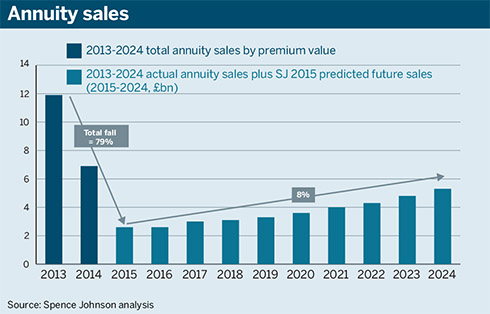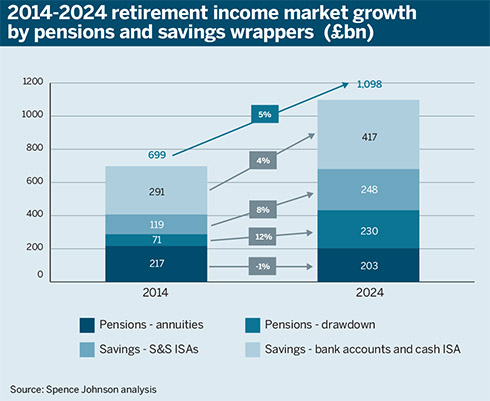We are seeing the annuity market being reshaped before our eyes with astonishing speed. It is sometimes said that pension freedoms have destroyed the annuity market, but is this true?
We are seeing the annuity market being reshaped before our eyes with astonishing speed. It is sometimes said that pensions freedoms have destroyed the annuity market, but is this true?
We are tracking what we call the ‘rebalancing’ of the retirement income pensions market towards Isas and drawdown, and away from annuities.
Our analysis shown in the chart here suggests that the total ‘retirement income’ market as we define it today is £699bn. It will grow to more than £1trn by 2024.
By then the annuity reserves will have fallen from 31 per cent of this pool today, to a mere 19 per cent of the total. The drawdown part of the market alone will exceed annuity reserves.

The rebalancing trend we have identified was not, however, created only by the 2015 pension freedoms. Indeed it was part of our predictions well before the freedoms were announced.
However, the new freedoms have significantly increased both the rate of change and indeed the likelihood that this rebalancing of the market will occur.
Sales of individual annuities are likely to return to a growth rate of 8 per cent a year over the next 10 years
There has certainly been a huge shrinkage in annuity sales in the past two years. We predict annuity sales will fall again this year to the equivalent of 21 per cent of 2013 levels. By and large this decline in sales is being driven by the collapse of annuities among smaller pot sizes as people take cash or choose drawdown.
But as you can see, we don’t think this shrinkage will persist. Insurers will not sit still. With the new freedoms allowed by the 2014 Budget, the annuity market is set to change drastically with a wave of variable, deferred and ‘with care’ annuity innovation to provide a more flexible income better suited to client needs.
In addition, after 2015 there will be a significant weight of money coming through the pensions market as it transitions from defined benefit to DC.
Overall, sales of individual annuities are likely to return to a growth rate of 8 per cent a year over the next 10 years.

In other words, while annuity reserves will not grow, they will not disappear either: there will still be more than £200bn in annuity reserves in 2024.
Annuity reserves might have grown in the next 10 years by another £100bn or so if pension freedoms had not been introduced. So insurers are presumably taking little comfort from the fact they will still have an annuity business in 2024, because they are probably too busy bemoaning the fact that George Osborne has, in effect, deprived them of the opportunity to gather an estimated £100bn of additional annuity reserve assets by 2024.
So, while the annuity market has certainly been radically changed in the past two years, it has not been destroyed.
As annuity providers sit down with the regulators to discuss yet another wave of reforms, they may feel a little down, but they are far from out.
Magnus Spence is managing director of Spence Johnson














